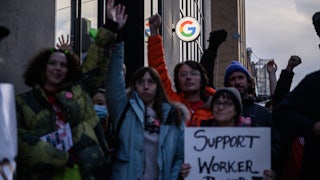Before the Nazi invasion of France in the spring of 1940, the Wehrmacht distributed to German troops the drug Pervitin, a pill form of methamphetamine that could keep soldiers awake for days. As Norman Ohler explains in his 2017 book Blitzed: Drugs in the Third Reich, Pervitin was developed by the Third Reich (in a chemical factory expropriated from its Jewish co-owner) specifically as a “performance-enhancing drug”—to win the war.
Allied troops mimicked, on a much smaller scale and without comparable state sanction, German reliance on amphetamines, and West German soldiers continued gobbling Pervitin into the 1960s. But the application of drugs to enhance human capital is, especially outside a wartime context, essentially fascist. It’s very much of a piece with Benito Mussolini’s conceit that the people are “a precious mineral” in need of molding, and with Goebbels’s parallel conceit that he could, “out of the raw material of the masses,” fashion “a solid, well-wrought structure of a Volk.”
I dredge up this unlovely history because it seems to have been forgotten in Silicon Valley, which has become the nation’s trendsetter in commerce-driven pharmacology. “Routine drug use,” Kirsten Grind and Katherine Bindley reported Monday in The Wall Street Journal,
has moved from an after-hours activity squarely into corporate culture, leaving boards and business leaders to wrestle with their responsibilities for a workforce that frequently uses. At the vanguard are tech executives and employees who see psychedelics and similar substances, among them psilocybin, ketamine and LSD, as gateways to business breakthroughs.
This follows a Businessweek report earlier this month on “ketamine retreats,” at which employees line up dutifully to be injected with 100 milligrams of the stuff. “We hope to take them out of the healing-only realms,” explained the chief clinical officer of Numinus Wellness Inc., a Vancouver-based ketamine peddler. I asked Thomas Frank—who, after seeing corporations like Apple appropriate the 1960s counterculture, coined the hilariously cynical slogan “commodify your dissent”—what he thought of this trend. “It looks like the counterculture has finally met its corporate telos,” he replied.
Let me make clear that I’m no pharmacological scold. I popped two antidepressants this morning. Prescription drugs are a useful tool to preserve mental health. Nor do I object to recreational drug use, within reason. I’m a little unclear why the foodie scribbler Michael Pollan loves to microdose, because I haven’t read How to Change Your Mind, but if it’s not too dangerous (I gather it isn’t), and if it assists his pursuit of happiness, godspeed. Even if it is dangerous and fails to help Pollan self-actualize, that’s really none of my business. Do Native Americans want to maintain their tradition of incorporating peyote into religious ceremonies? Sure, why not (though the Supreme Court imposes certain limits)?
But to apply any drug more powerful than caffeine to utilitarian purposes that bypass the demands of the self gives me the fantods. No greater corporate good is served by dosing a firm’s employees. (“Elon Musk takes ketamine,” the Journal piece begins. Not a persuasive argument!) Or, if some corporate good is served, it isn’t worth the cost in human dignity. A solid, well-wrought structure of a workforce is no less inherently fascist a goal than a solid, well-wrought structure of a Volk. At a moment when society trembles at the imminent onslaught, real or imagined, of artificial intelligence, it’s no answer to turn human beings into machines.
It’s telling how different social classes require different pharmacological tinkering. Crystal meth is (or at least started out as) the drug of the working class, initially cheap to buy and easy to make from cold medicines. In his 2009 book Methland, the journalist Nick Reding observed that as deindustrialization spread during the 1980s, meth enabled blue-collar workers to take on double shifts or to work two jobs to earn what one shift or one job had paid previously. There was, Reding wrote, simultaneously “a steady long-term rise in the abuse of a drug associated with hard work and a steady long-term decline in the amount of work available in America’s defining industries.” The proletariat took crystal meth to work longer and harder. Those who couldn’t cope with this desperate spiral turned from uppers to downers, creating today’s opioid epidemic.
Magic mushrooms, LSD, and ketamine serve an entirely different purpose for a higher social stratum from whom employers demand not quantity so much as quality. Spencer Shulem, CEO of a start-up called BuildBetter.ai, explained to the Journal that LSD helped him think more creatively to meet the sky-high expectations of venture capitalists. “They don’t want a normal person, a normal company,” he told the Journal. “They want something extraordinary. You’re not born extraordinary.”
If Shulem’s sad story has the ring of familiarity, it’s because psychedelics may have taken over the same (though less socially sanctioned) function as cocaine in the 1970s and 1980s. Cocaine was more dangerous (today it’s more dangerous still), and your boss wouldn’t likely advise you to snort it. But cocaine too was believed to fuel creativity, energy, and, above all, confidence amid the corporate rat race. I can vouch for this last. The two times I tried coke (both in the 1980s) I was overwhelmed with a blinding realization of my own superiority, of which, inexplicably, I’d previously been unaware. I was, I understood suddenly, a magnificent human being. The force of this delusion frightened me so much that I never took the stuff again. But I could see how it might make people fancy themselves more formidable.
Unlike a joint, which can be passed around freely among a large group of people, cocaine is so expensive that when somebody brings it to a party they have to choose a small select group to invite quietly into the next room for a snort. The invidiousness is at least as intoxicating as the high. That sense of exclusivity is recreated in the ayahuasca retreats that Tim Sae Koo, founder of a digital marketing start-up in San Francisco, hosts in Costa Rica for tech entrepreneurs and CEOs. Data-entry clerks need not apply. The highlight is a hallucinogenic brew that, according to Woo, may cause you to vomit (or, I’m reliably informed, expel at the other end). Or it may cause you to see the world with new eyes. Step right up and discover whether you’re one of the elect!
I’m not here to sneer at the exotic fads on which rich people waste their money. (Well, maybe a little.) What’s really troubling is the purpose. The upper classes’ ingestion of psychedelics to serve not themselves but the pitiless creative demands of capitalism is no less dehumanizing than the proletariat’s ingestion of crystal meth to increase capitalism’s demand for physical endurance. Willy Loman was liked but not well liked because he’d lost his salesman’s touch for schmoozing the customer, cocktail in hand. Imagine Death of a Salesman updated to 2023, with Willy tragically unable to envision the Next Big Thing while he drops acid with the new boss. The woods are burning. Attention must be paid.






